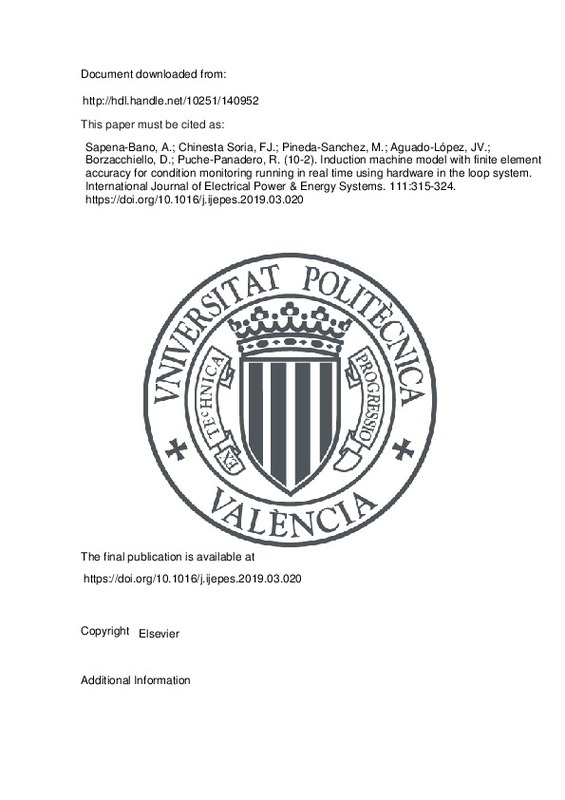JavaScript is disabled for your browser. Some features of this site may not work without it.
Buscar en RiuNet
Listar
Mi cuenta
Estadísticas
Ayuda RiuNet
Admin. UPV
Induction machine model with finite element accuracy for condition monitoring running in real time using hardware in the loop system
Mostrar el registro sencillo del ítem
Ficheros en el ítem
| dc.contributor.author | Sapena-Bano, Angel
|
es_ES |
| dc.contributor.author | CHINESTA SORIA, FRANCISCO JOSE
|
es_ES |
| dc.contributor.author | Pineda-Sanchez, Manuel
|
es_ES |
| dc.contributor.author | Aguado-López, Jose Vicente
|
es_ES |
| dc.contributor.author | Borzacchiello, D.
|
es_ES |
| dc.contributor.author | Puche-Panadero, Rubén
|
es_ES |
| dc.date.accessioned | 2020-04-17T12:51:26Z | |
| dc.date.available | 2020-04-17T12:51:26Z | |
| dc.date.issued | 2019-10 | es_ES |
| dc.identifier.issn | 0142-0615 | es_ES |
| dc.identifier.uri | http://hdl.handle.net/10251/140952 | |
| dc.description.abstract | [EN] Most industrial processes are run by induction machines (IMs). Condition monitoring of IM assures their continuity of service, and it may avoid highly costly breakdowns. Among the methods for condition monitoring, online motor current signature analysis is being attracting a rising interest, because it is non-invasive, and it can identify a wide variety of faults at early stage. To favour the development of on-line fault diagnosis techniques, it is necessary to have real-time currents with which test the new techniques and devices. Models running in real time in hardware-in-the-loop (HIL) simulators are a suitable alternative to balance the drawbacks of test benches (costly, limited machines, faults and working conditions). These models must be accurate enough to reflect the effects of a fault and they must be running in real time. A promising technique based on the equivalent circuit parameters calculation of IM by finite element analysis (FEA) is attracting a rising interest due to its reliability, performance and the possibility of being run in a HIL. Nevertheless, prior to running in a HIL, it is necessary to compute the IM parameters using FEA, which requires long simulation times and high computing resources. Consequently, covering a whole range of degrees of a giving fault could be unaffordable. What is proposed in this paper is to apply the sparse subspace learning (SSL) in combination with the hierarchical Lagrangian interpolation (HLI) to obtain the parametric solutions of the faulty IM model that cover the whole range of severity of a given fault, with a reduced number of FEA simulations. By means of this approach it is possible not only to boost the computation speed but also to achieve a significant reduction of memory requirements while retaining reasonable accuracy compared to traditional FEA, so enabling the real-time simulation of predictive models. | es_ES |
| dc.description.sponsorship | This work was supported by the Spanish "Ministerio de Education, cultura y Deporte" in the framework of the "Programa Estatal de Promotion del Talento y su Empleabilidad en I+D+i, Subprograma Estatal de Movilidad, del Plan Estatal de Investigation Cientifica y Tecnica y de Innovacion 2013-2016" in the subframework "Estancias de movilidad en el extranjero Jose Castillejo para jovenes doctores". | es_ES |
| dc.language | Inglés | es_ES |
| dc.publisher | Elsevier | es_ES |
| dc.relation.ispartof | International Journal of Electrical Power & Energy Systems | es_ES |
| dc.rights | Reserva de todos los derechos | es_ES |
| dc.subject | Fault diagnosis | es_ES |
| dc.subject | Hierarchical Lagrange interpolation | es_ES |
| dc.subject | Induction machines | es_ES |
| dc.subject | Model order reduction | es_ES |
| dc.subject | Sparse subspace learning | es_ES |
| dc.subject.classification | FISICA APLICADA | es_ES |
| dc.subject.classification | INGENIERIA ELECTRICA | es_ES |
| dc.title | Induction machine model with finite element accuracy for condition monitoring running in real time using hardware in the loop system | es_ES |
| dc.type | Artículo | es_ES |
| dc.identifier.doi | 10.1016/j.ijepes.2019.03.020 | es_ES |
| dc.rights.accessRights | Abierto | es_ES |
| dc.contributor.affiliation | Universitat Politècnica de València. Departamento de Ingeniería Eléctrica - Departament d'Enginyeria Elèctrica | es_ES |
| dc.description.bibliographicCitation | Sapena-Bano, A.; Chinesta Soria, FJ.; Pineda-Sanchez, M.; Aguado-López, JV.; Borzacchiello, D.; Puche-Panadero, R. (2019). Induction machine model with finite element accuracy for condition monitoring running in real time using hardware in the loop system. International Journal of Electrical Power & Energy Systems. 111:315-324. https://doi.org/10.1016/j.ijepes.2019.03.020 | es_ES |
| dc.description.accrualMethod | S | es_ES |
| dc.relation.publisherversion | https://doi.org/10.1016/j.ijepes.2019.03.020 | es_ES |
| dc.description.upvformatpinicio | 315 | es_ES |
| dc.description.upvformatpfin | 324 | es_ES |
| dc.type.version | info:eu-repo/semantics/publishedVersion | es_ES |
| dc.description.volume | 111 | es_ES |
| dc.relation.pasarela | S\384448 | es_ES |
| dc.contributor.funder | Ministerio de Educación, Cultura y Deporte | es_ES |







![[Cerrado]](/themes/UPV/images/candado.png)

